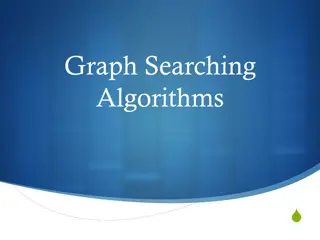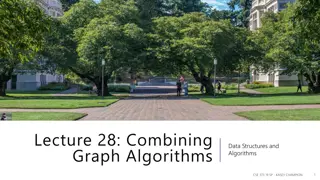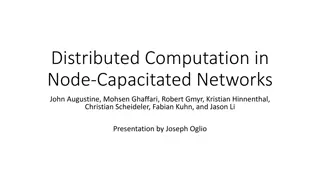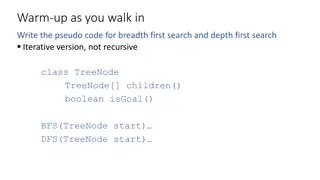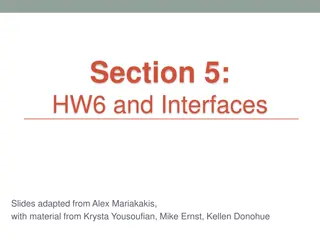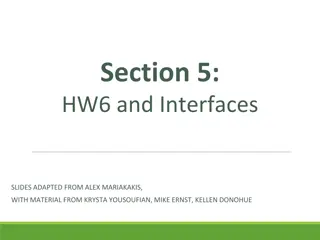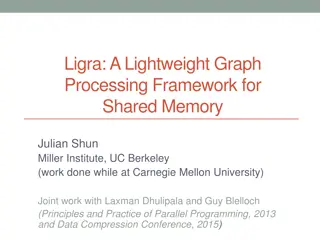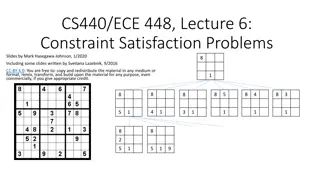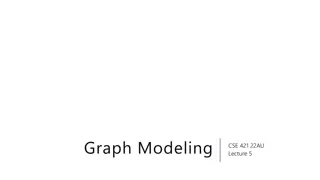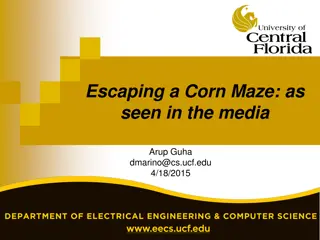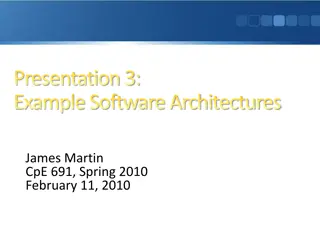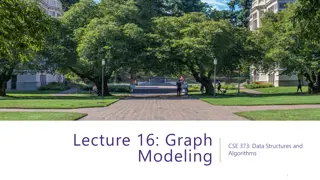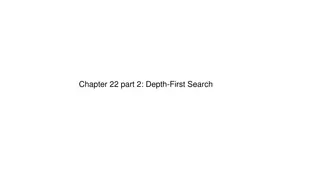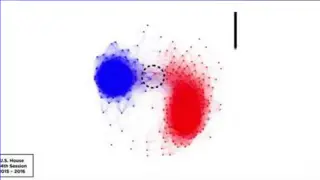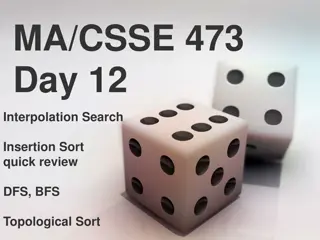
Graph Theory and Bipartite Graphs
Discover the concepts of BFS and DFS in the context of unweighted graphs, and learn how to find shortest paths and connected components efficiently. Explore the application of BFS in identifying bipartite graphs and understand the characteristics of odd cycles in graph theory.
Download Presentation

Please find below an Image/Link to download the presentation.
The content on the website is provided AS IS for your information and personal use only. It may not be sold, licensed, or shared on other websites without obtaining consent from the author. If you encounter any issues during the download, it is possible that the publisher has removed the file from their server.
You are allowed to download the files provided on this website for personal or commercial use, subject to the condition that they are used lawfully. All files are the property of their respective owners.
The content on the website is provided AS IS for your information and personal use only. It may not be sold, licensed, or shared on other websites without obtaining consent from the author.
E N D
Presentation Transcript
BFS and DFS CSE 417 Winter 2024 Lecture 6 xkcd.com/2407
Old Breadth-First Search Application Shortest paths in an unweighted Finding the connected components of an undirected unweighted graph. undirected graph. Both run in (? + ?) time, where ? is the number of edges (also written ? or |?|) And ? is the number of vertices (also written ? or |?|)
Unweighted Graphs If the graph is unweighted, how do we find a shortest paths? u w s y t v x What s the shortest path from s to s? Well .we re already there. What s the shortest path from s to u or v? Just go on the edge from s From s to w,x, or y? Can t get there directly from s, if we want a length 2 path, have to go through u or v. CSE 373 19 SU - ROBBIE WEBER 3
A new application Bipartite (also called 2 Bipartite (also called 2- -colorable ) colorable ) A graph is bipartite (also called 2-colorable) if the vertex set can be divided into two sets ?1,?2 such that every edge goes between ?1 and ?2. Called 2-colorable because you can color ?1 red and ?2 blue, and no edge connects vertices of the same color. We ll adapt BFS to find if a graph is bipartite And prove a graph theory result along the way.
A new application Bipartite (also called 2 Bipartite (also called 2- -colorable ) colorable ) A graph is bipartite (also called 2-colorable) if the vertex set can be divided into two sets ?1,?2 such that the every edge goes between ?1 and ?2. Called 2-colorable because you can color ?1 red and ?2 blue, and no edge connects vertices of the same color. If a graph contains an odd cycle, then it is not bipartite. Try the example on the right, then proving the general theorem in the light purple box. Help Robbie figure out how long to make the explanation Pollev.com/robbie
Lemma 1 If a graph contains an odd cycle, then it is not bipartite. Start from any vertex, and give it either color. Its neighbors must must be the other color. Their neighbors must be the first color The last two vertices (which are adjacent) must be the same color. Uh-oh.
Layers Can we have an edge that goes from layer ? to layer ? + 2 (or lower)? No! If ? is in layer ?, then we processed its edge while building layer ? + 1, so the neighbor is no lower than layer ?. Can you have an edge within a layer? Yes! If ? and ? are neighbors and both have a neighbor in layer ?, they both end up in layer ? + 1 (from their other neighbor) before the edge between them can be processed.
BFS With Layers search(graph) toVisit.enqueue(first vertex) mark first vertex as seen toVisit.enqueue(end-of-layer-marker) l=1 while(toVisit is not empty) current = toVisit.dequeue() if(current == end-of-layer-marker) l++ toVisit.enqueue(end-of-layer-marker) current.layer = l for (v : current.neighbors()) if (v is not seen) mark v as seen toVisit.enqueue(v) It s just BFS! With some extra bells and whistles.
Testing Bipartiteness How can we use BFS with layers to check if a graph is 2-colorable? Well, neighbors have to be the other color Where are your neighbors? Hopefully in the next layer or previous layer Color all the odd layers red and even layers blue. Does this work?
Lemma 2 If BFS has an intra-layer edge, then the graph has an odd- length cycle. An intra-layer edge is an edge within a layer. Follow the predecessors back up, layer by layer. Eventually we end up with the two vertices having the same predecessor in some level (when you hit layer 1, there s only one vertex) Since we had two vertices per layer until we found the common vertex, we have 2? + 1 vertices that s an odd number!
Lemma 3 If a graph has no odd-length cycles, then it is bipartite. Prove it by contrapositive contrapositive The contrapositive implication is the same one prove that instead!
Lemma 3 If a graph has no odd-length cycles, then it is bipartite. Prove it by contrapositive contrapositive The contrapositive implication is the same one prove that instead! We want to show if a graph is not bipartite, then it has an odd-length cycle. Suppose ? is not bipartite. Then the coloring attempt by BFS-coloring must fail. Edges between layers can t cause failure there must be an intra-level edge causing failure. By Lemma 2, we have an odd cycle.
The Big Result Bipartite (also called 2 Bipartite (also called 2- -colorable ) colorable ) A graph is bipartite if and only if it has no odd cycles. Proof: Lemma 1 says if a graph has an odd cycle, then it s not bipartite (or in contrapositive form, if a graph is bipartite, then it has no odd cycles) Lemma 3 says if a graph has no odd cycles then it is bipartite. Lemma 1: If a graph contains an odd cycle, then it is not bipartite. Lemma 3: If a graph has no odd-length cycles, then it is bipartite.
The Big Result The final theorem statement doesn t know about the algorithm we used the algorithm to prove a graph theory fact!
Wrapping it up BipartiteCheck(graph) //assumes graph is connected! toVisit.enqueue(first vertex) mark first vertex as seen toVisit.enqueue(end-of-layer-marker) l=1 while(toVisit is not empty) current = toVisit.dequeue() if(current == end-of-layer-marker) l++ toVisit.enqueue(end-of-layer-marker) current.layer = l for (v : current.neighbors()) if (v is not seen) mark v as seen toVisit.enqueue(v) else //v is seen if(v.layer == current.layer) return not bipartite //intra-level edge return bipartite //no intra-level edges
Testing Bipartiteness Our algorithm should answer yes or no yes ?is bipartite or no ?isn t bipartite Whenever this happens, you ll have two parts to the proof: If the right answer is yes, then the algorithm says yes. If the right answer is no, then the algorithm says no. OR If the right answer is yes, then the algorithm says yes. If the algorithm says yes, then the right answer is yes.
Proving Algorithm Correct If the graph is bipartite, then by Lemma 1 there is no odd cycle. So by the contrapositive of lemma 2, we get no intra-level edges when we run BFS, thus the algorithm (correctly) returns the graph is bipartite. If the algorithm returns that the graph is bipartite, then we cannot have any intra-level edges (since we check every edge in the course of the algorithm). We proved earlier that there are no edges skipping more than one level. So if we assign odd levels to red and even levels to blue the algorithm has verified that there are no edges between vertices of the same color. So the graph is bipartite by definition.
DFS vs. BFS In BFS, we explored a graph level-wise We explored everything next to the starting vertex. Then we explored everything one step further away. Then everything one step further
DFS vs. BFS In DFS, we explore deep into the graph. We try to find new (undiscovered) nodes, then backtrack when we re out of new ones.
DFS pseudocode In 373, you probably took your BFS code, replaced the queue with a stack and said that s the pseudocode. That s a really nice object lesson in stacks. No one actually writes DFS that way (except in data structures courses). You ll basically always see the recursive version instead. (using the call stack instead of the data structure stack)
DFS pseudocode Instead of using an explicit stack, we re going to use recursion The call stack is going to be our stack. We want to explore as deeply as possible from each of our outgoing edges DFS(u) Mark u as seen For each edge (u,v) //leaving u If v is not seen DFS(v) End If End For
DFS pseudocode Both the explicit stack version and the recursive version are DFS. For example, they can both traverse through the graph in the same fundamental way. You can use them for similar applications. But they re not identical they actually use the stack in different ways. If you re trying to convert from one to the other, you ll have to think carefully to do it.
DFS(u) Running DFS Mark u as seen For each edge (u,v) //leaving u If v is not seen DFS(v) End If End For Start from A F G A Vertex: D Last edge used: -- Vertex: C Last edge used: (C,D) Last edge used: --- Last edge used: (E,F) Vertex: D Vertex: F Last edge used: --- Last edge used: (F,D) Vertex: F E Last edge used: (D,B) Vertex: E Vertex: E Vertex: C Last edge used: -- Vertex: B Vertex: B B Vertex: B Last edge used: -- Last edge used: (B,C) Last edge used: (B,E) D C Vertex: A Vertex: A Vertex: A Last edge used: --- Last edge used: (A,B) Last edge used: (A,F)
DFS(u) Running DFS Mark u as seen For each edge (u,v) //leaving u If v is not seen DFS(v) End If End For HEY! We missed something! F G A E DFS discovery DFS(v) finds exactly the (unseen) vertices reachable from ?. B D C
Reaching Everything One possible use of DFS is visiting every vertex How can we make sure that happens? What did you do for BFS when you had this problem? Add a while loop, and call DFS from each vertex. DFSWrapper(G) For each vertex u of G If u is not seen End If End For DFS(u) Mark u as seen For each edge (u,v) //leaving u If v is not seen DFS(v) End If End For DFS(u)
Bells and Whistles Depending on your application, you may add a few extra lines to the DFS code to compute the thing you want. Usually just an extra variable or two per vertex. For today s application, we need to know what order vertices come onto and off of the stack. DFS(u) Mark u as seen u.start = counter++ For each edge (u,v) //leaving u If v is not seen DFS(v) End If End For u.end = counter++ DFSWrapper(G) counter = 1 For each vertex u of G If u is not seen End If End For DFS(u)
Edge Classification When we use DFS to search through a graph, we ll have different kinds of edges. Like when we did BFS, we had: Edges that went from level ? to level ? + 1 Intra-level edges. We ll do a few examples to help classify the edges. Then do an application of the classification. Our goal: find a cycle in a directed graph.
DFS(u) Running DFS Mark u as seen u.start = counter++ For each edge (u,v) //leaving u If v is not seen DFS(v) End If End For u.end = counter++ 8 9 Start from A F G 1 12 A Vertex: D Last edge used: -- Vertex: C Last edge used: (C,D) Last edge used: --- Last edge used: (E,F) Vertex: D Vertex: F Last edge used: --- Last edge used: (F,D) Vertex: F E Last edge used: (D,B) Vertex: E Vertex: E Vertex: C Last edge used: -- Vertex: B Vertex: B 7 10 B Vertex: B Last edge used: -- Last edge used: (B,C) Last edge used: (B,E) D 2 11 C Vertex: A Vertex: A Vertex: A 4 5 Last edge used: --- Last edge used: (A,B) Last edge used: (A,F) 3 6
DFS(u) Mark u as seen u.start = counter++ For each edge (u,v) //leaving u If v is not seen DFS(v) End If End For u.end = counter++ F G A E B D C
The orange edges (the ones where we discovered a new vertex) form a tree!* We call them tree edges. 1 12 2 11 That blue edge went from a descendent to an ancestor B was still on the stack when we found (B,D). We call them back edges. 3 6 The green edge went from an ancestor to a descendant F was put on and come off the stack between putting A on the stack and finding (A,F) We call them forward edges. The purple edge went some other way. D had been on and come off the stack before we found F or (F,D) We call those cross edges. 4 5 7 10 *Conditions apply. Sometimes the graph is a forest. But we call them tree edges no matter what. 8 9
Edge Classification (for DFS on directed graphs) Edge type Definition When is (?,?) that edge type? Tree Edges forming the DFS tree (or forest). ? was not seen before we processed ?,? . ? and ? have been seen, and u.start < v.start < v.end < u.end ? and ? have been seen, and v.start < u.start < u.end < v.end Forward From ancestor to descendant in tree. Back From descendant to ancestor in tree. Cross Edges going between vertices without an ancestor relationship. ? and ? have not been seen, and v.start < v.end < u.start < u.end The third column doesn t look like it encompasses all possibilities. It does the fact that we re using a stack limits the possibilities: e.g. u.start < v.start < u.end < v.end is impossible. And the rules of the algorithm eliminate some other possibilities.
Try it Yourselves! DFSWrapper(G) counter = 0 For each vertex u of G If u is not seen End If End For 1 12 A 7 8 C 2 11 B DFS(u) 4 5 cross 3 10 D DFS(u) F E 6 9 Mark u as seen u.start = counter++ For each edge (u,v) //leaving u If v is not seen DFS(v) End If End For u.end = counter++
Actually Using DFS Here s a claim that will let us use DFS for something! Back Edge Characterization DFS run on a directed graph has a back edge if and only if it has a cycle.
Forward Direction If DFS on a graph has a back edge then it has a cycle. Suppose the back edge is (?,?). A back edge is going from a descendant to an ancestor. So we can go from ? back to ? on the tree edges. That sounds like a cycle!
Backward direction This direction is trickier. Here s a proof it has the right intuition, but (at least) one bug. Suppose G has a cycle ?0,?1, ,??. Without loss of generality, let ?0 be the first node on the cycle DFS marks as seen. For each ? there is an edge from ?? to ??+1. We discovered ?0 first, so those will be tree edges. When we get to ??, it has an edge to ?0 but ?0 is seen, so it must be a back edge. Talk to your neighbors to find a bug then try to fix it.
Fixing the Backward Direction We might not just walk along the cycle in order. Are we going to visit ?? in time or might ??,?0 be a cross edge? DFS discovery DFS(v) finds exactly the (unseen) vertices reachable from ?.
Fixing the Backward Direction We might not just walk along the cycle in order. Are we going to visit ?? in time or might ??,?0 be a cross edge? Suppose G has a cycle ?0,?1, ,??. Without loss of generality, let ?0 be the first node on the cycle DFS marks as seen. For each ? there is an edge from ??to ??+1. We discovered ?0 first, so those will be tree edges. When we get to ??, it has an edge to ?0 but ?0 is seen, so it must be a back edge. ?? is reachable from ?0 so we must reach ?? before ?0 comes off the stack.
Summary DFS discovery DFS(v) finds exactly the (unseen) vertices reachable from ?. Back Edge Characterization A directed graph has a back edge if and only if it has a cycle.
Edge Classification (for DFS on directed graphs) Edge type Definition When is (?,?) that edge type? Tree Edges forming the DFS tree (or forest). ? was not seen before we processed ?,? . ? and ? have been seen, and u.start < v.start < v.end < u.end ? and ? have been seen, and v.start < u.start < u.end < v.end Forward From ancestor to descendant in tree. Back From descendant to ancestor in tree. Cross Edges going between vertices without an ancestor relationship. ? and ? have not been seen, and v.start < v.end < u.start < u.end The third column doesn t look like it encompasses all possibilities. It does the fact that we re using a stack limits the possibilities: e.g. u.start < v.start < u.end < v.end is impossible. And the rules of the algorithm eliminate some other possibilities.
BFS/DFS caveats and cautions Edge classifications are different for directed graphs and undirected graphs. DFS in undirected graphs don t have cross edges. BFS in directed graphs can have edges skipping levels (only as back edges, skipping levels up though!)
Summary Graph Search Applications BFS Shortest Paths (unweighted) graphs) DFS Cycle detection (directed graphs) Topological sort Strongly connected components Cut edges (on homework) EITHER 2-coloring Connected components (undirected) Usually use BFS easier to understand.


